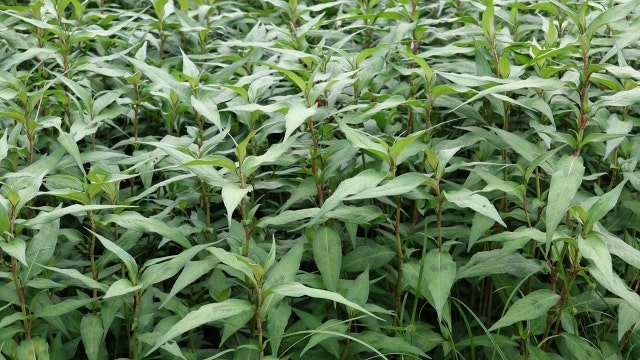South Asian herb dubbed 'smart weed'
Chris Kilham, the Medicine Hunter, talks to Dr. Manny about the health benefits of kesum
In a field not too far from the famous Batu caves outside of Kuala Lumpur Malaysia, a group of us inspect a verdant and fragrant crop of kesum, a popular herb used in traditional Malaysian, Thai and Vietnamese cookery, sometimes as a curry seasoning, and sometimes as an ulam, a green salad vegetable. We are observing about 6 acres of the herb, growing like paddy in shallow water, right up against some of Malaysia’s remarkable 60 million-year-old rainforest. Our group includes a woman who plants and harvests kesum, a field biologist, a couple of other agricultural specialists, and two men from a botanical extraction company. Rumbling clouds portending a heavy rain warn us of soaking wet weather in minutes.
Kesum, which alternately goes by the botanical names Polygonum Minus or Persicaria minor, grows from seed to maturity in 90 days, and has the fresh flavor of basil and oregano together, with its own unique aroma. The farm we are visiting harvests and bundles a ton of kesum every day for the local fresh markets. In homes and local restaurants, kesum, also known as laksa leaf, finds a way into many regional dishes. Notable among them is a famous Malaysian salad called kerabu, which also contains shrimp, hot chiles, peanuts and lime.
In the United States, kesum has appeared in Thai and Vietnamese cuisine for decades, and you’d probably recognize its distinctive fresh aroma. Now, scientific inquiry into kesum has opened a new area of use as a cognitive enhancer, a mental sharpening agent that works without apparent negative effects. The herb is loaded with beneficial antioxidants — from carotenes, and vitamins C and E, to a host of flavonoids, catechins and more.
The plant has been used as a traditional remedy for centuries, according to Datin Sharifah Anisah, perhaps Malaysia’s most knowledgeable expert on the traditional uses of Malaysian plants. It can be eaten as food, drunk as a tea, applied to skin, and employed for a variety of purposes from detoxification to enhancing immunity. Traditionally the plant has earned the name “smart weed,” for its mind-sharpening effects.
These effects were put to the test in a study of 35 healthy women, half of who were given a concentrated extract of kesum daily, while the other half received a placebo. At the commencement of the study, after three weeks, and after six weeks, the subjects were given a series of psychological and intelligence tests. The kesum extract group scored higher in overall good mood, short-term memory, and IQ. Several parameters of cognitive function improved. This 2015 study, reported in the medical journal Clinical Interventions in Aging, has piqued interest in the popular herb.
Topically, kesum has a future in the cosmetic sector. Recent investigation into the topical use of the extract shows that kesum has a youth-enhancing effect, causing the formation of new healthy collagen, the primary building material of skin tissue. This will make the extract a candidate for inclusion into anti-aging creams and serums.
At Forest Research Institute Malaysia (FRIM), the premier botanical research center in that country, one of the center’s botanists tells us of ways that FRIM itself is launching both a kesum seasoning and a kesum tea, to make the benefits of the plants even more available to the general public. Specimens of kesum grow in pots under a shed roof, and in the herbarium at the center, voucher samples of kesum are used to ensure proper identity of the plant.
Several of us fly to Kota Bharu, south of Kuala Lumpur in Kelantan state, to visit the legendary Pasar Siti Khadijah, a very large and colorful market run almost entirely by women. The dry market features household goods, knives, brooms, and all manner of general supplies, while the wet market features fish, meat, fruits, vegetables, herbs and spices. We make our way into the wet market, and immediately spot large piles of kesum stacked at almost every stall. As we stand near one stall, a woman approaches the vendor, and purchases a generous armload of kesum. We follow her upstairs to the restaurant area, and watch her finely chop the pile of kesum for the salads that will be served over the next few hours. She laughs at me as I take her photo.
Kesum is also cultivated in the U.S., by farmers who serve Thai restaurant suppliers. And while the primary consumption of kesum is in Southeast Asian cuisine, the new science on kesum suggests that another area of growth for the plant will be in both the nutritional supplement and cosmetic sectors. Kesum, a popular herb and salad vegetable, is making its way into the arena of scientifically-corroborated remedies for the brain and skin, and is now poised to achieve even greater recognition.
Chris Kilham is a medicine hunter who researches natural remedies all over the world, from the Amazon to Siberia. Chris advises herbal, cosmetic and pharmaceutical companies, is a regular guest on radio and TV programs worldwide, and is the author of fifteen books. Read more at MedicineHunter.com.





















